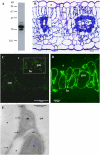The Flaveria bidentis beta-carbonic anhydrase gene family encodes cytosolic and chloroplastic isoforms demonstrating distinct organ-specific expression patterns
- PMID: 17496111
- PMCID: PMC1914143
- DOI: 10.1104/pp.107.098152
The Flaveria bidentis beta-carbonic anhydrase gene family encodes cytosolic and chloroplastic isoforms demonstrating distinct organ-specific expression patterns
Abstract
Carbonic anhydrase (CA) catalyzes the interconversion of CO(2) and bicarbonate, the forms of inorganic carbon used by the primary carboxylating enzymes of C(3) and C(4) plants, respectively. Multiple forms of CA are found in both photosynthetic subtypes; however, the number of isoforms and the location and function of each have not been elucidated for any single plant species. Genomic Southern analyses showed that the C(4) dicotyledon Flaveria bidentis 'Kuntze' contains a small gene family encoding beta-CA and cDNAs encoding three distinct beta-CAs, named CA1, CA2, and CA3, were isolated. Quantitative reverse transcription-polymerase chain reactions showed that each member of this beta-CA family has a specific expression pattern in F. bidentis leaves, roots, and flowers. CA3 transcripts were at least 50 times more abundant than CA2 or CA1 transcripts in leaves. CA2 transcripts were detected in all organs examined and were the most abundant CA transcripts in roots. CA1 mRNA levels were similar to those of CA2 in leaves, but were considerably lower in roots and flowers. In vitro import assays showed CA1 was imported into isolated pea (Pisum sativum) chloroplasts, whereas CA2 and CA3 were not. These results support the following roles for F. bidentis CAs: CA3 is responsible for catalyzing the first step in the C(4) pathway in the mesophyll cell cytosol; CA2 provides bicarbonate for anapleurotic reactions involving nonphotosynthetic forms of phosphoenolpyruvate carboxylase in the cytosol of cells in both photosynthetic and nongreen tissues; and CA1 carries out nonphotosynthetic functions demonstrated by C(3) chloroplastic beta-CAs, including lipid biosynthesis and antioxidant activity.
Figures





References
-
- Atkins C, Smith P, Mann A, Thumfort P (2001) Localization of carbonic anhydrase in legume nodules. Plant Cell Environ 24 317–326
-
- Atkins CA (1974) Occurrence and some properties of carbonic anhydrases from legume root nodules. Phytochemistry 13 93–98
-
- Bläsing OE, Ernst K, Streubel M, Westhoff P, Svensson P (2002) The non-photosynthetic phosphoenolpyruvate carboxylases of the C4 dicot Flaveria trinervia—implications for the evolution of C4 photosynthesis. Planta 215 448–456 - PubMed
-
- Bracey MH, Christiansen J, Tovar P, Cramer SP, Bartlett SG (1994) Spinach carbonic anhydrase: investigation of the zinc-binding ligands by site-directed mutagenesis, elemental analysis, and EXAFS. Biochemistry 33 13126–13131 - PubMed
Publication types
MeSH terms
Substances
Associated data
- Actions
- Actions
- Actions
LinkOut - more resources
Full Text Sources
Molecular Biology Databases
Miscellaneous

